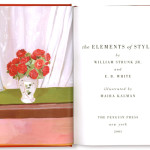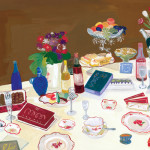By MARIA LACRETA
The artist Maira Kalman and fellow cartooning hand Roz Chast gave a talk a couple of weeks ago at the ICA, entitled, A Shaky Yet Curiously Enlightening Evening with Roz Chast and Maira Kalman Who Will Show Work and Then Answer with Chipper Doubt Any Questions You Might Have About This, That, or the Other. Kalman and Chast, who for years have both had persistent and committed stints as illustrator and cartoonist for the New Yorker, came with two different approaches to discuss and show their work.
Kalman, who took a more personal approach on the inspiration for her images, percolated with family stories about how, where and when the fodder arrives, including sitting in parks, daydreaming, or noticing human vending machines. Chast, showing us her cartoons and reading the captions, managed to get quite a few laughs from the audience, as she told it like it was, just as her cartoons do. Chast talked briefly about her recent collaboration with actor and writer, Steve Martin. She made some jokes and answered some questions about what it was like to work with Martin that led to more questions for the two women about collaboration in general, and what it is like to work with others and have it gel, or have a nightmare situation on your hands.
The Martin-Chast duo produced the new children’s book, “The Alphabet From A to Y With Bonus Letter Z!” Kalman has worked with Mark Morris on sets, Kate Spade on bag design, along with numerous other collaborative efforts with her late husband, designer, Tibor Kalman. If Chast was the stand-up comic of the night, Kalman was the confident maddened artist demanding to connect the work to her reality, and vice-versa. This wasn’t in such a dramatically profound manner, but in some sense it seemed necessary for her to proclaim the need for the works to supplement the life of the artist, to find the two connected at a very basic level--which seems to be the essence of most artists worth considering.
Ludwig Bemelmans, (b.1898-d.1962—author and illustrator of the Madeline books) was mentioned as an inspiration of Kalmans’---Bemelmans had also been a prolific contributor to the New Yorker and many other magazines, including the New Yorker’s precursor, New York World. This was important to hear about, as she identified the connection to Bemelmans in writing not only for children, with her wonderfully poetic and beautifully drawn books, such as my family’s favourites; Hey Willy”, “See The Pyramids, and, Ooh-la-la (Max In Love), but also the work for the adult audience. These newer works include an illustrated version of selections from William Strunk Jr. & E.B. White’s The Elements of Style, which she has illustrated. (Also, an aside, she has been working on other projects, including The Principles of Uncertainty, an opera based on her illustrated column of the same name.She spoke about tales from her own sister, mother, and various family members—answering a question about one character from Hey Willy, See The Pyramids, Maishel Shmelkin --and if he really did forgot to wear his pants, as the story goes...
Kalman answered back that he in fact did forget to wear his pants, and added, “that’s the beauty of having a family from a small village, where weird things happened 100 years ago, and we can still talk and laugh about them now,” or tell them as small snippets of history, to help us get a sort of cross-section of the picture, perhaps. Telling of the poetry in the children’s books, Kalman told us about a story her sister tells, about a man who dances on salt. Kalman knew nothing more than this one fact, and used the idea as material, saying , “the good thing about it not meaning anything (or having any reasoning) is—you don’t have to explain anything and you can go on to the next thing.”
The Israeli-born, New York raised gal, and all that that upbringing has entailed, seems to give Kalman a confident sharp wit and sincerity that fills her stories with a sense of absurdity and integrity you only get from the truth. Stories of her immigrant mother who’s broken English or broken-American methods served for a sense of poetry in Kalman’s life, or telling us of the lists Kalman made for herself as a child—“so that I could understand every minute of my life,” seem genuine and reinforce a clarity to her work. Kalman is fond of painting the whole body, right down to the peculiar shoes and fashions that her characters don. Like any of her fine illustrations of women in her books, Kalman herself seems identical to these personaes, right down to the pointed, fitted shoes. She seemed to be a part of her books, which for me spoke about her investment in her art, and the way we have to meld those worlds together. Sometimes making it difficult to make separations, which may be a reasoning or order for them to work right.
- The intro page from Elements of Style, Kalman’s book that was released in 2005.
- Maira Kalman, Be Obscure, from “Elements of Style”, 2005.
- Maira Kalman, a spread from Ooh-la-la, Max in Love, published by Viking Penguin, 1994.
"Maira Kalman and Roz Chast" spoke at the ICA on Wednesday, November 14th, 2007.
All images are courtesy of the artist.







